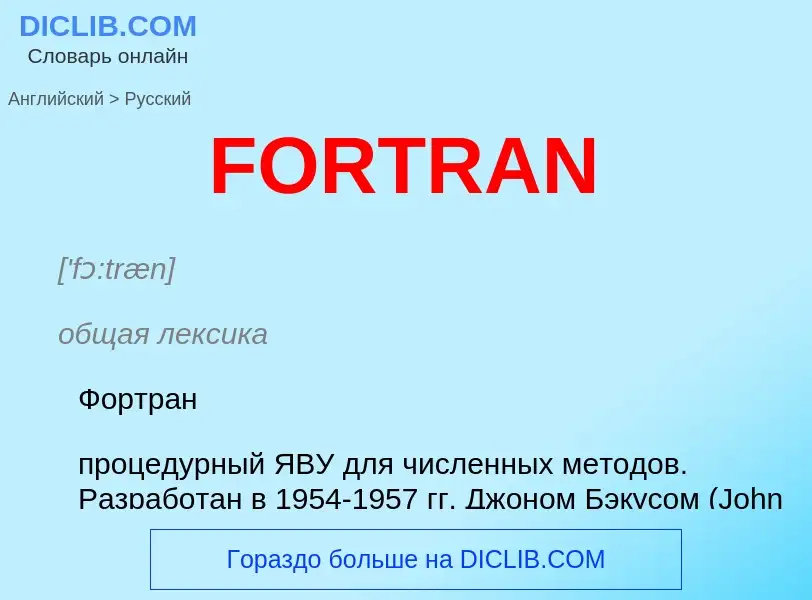Traduzione e analisi delle parole tramite l'intelligenza artificiale ChatGPT
In questa pagina puoi ottenere un'analisi dettagliata di una parola o frase, prodotta utilizzando la migliore tecnologia di intelligenza artificiale fino ad oggi:
- come viene usata la parola
- frequenza di utilizzo
- è usato più spesso nel discorso orale o scritto
- opzioni di traduzione delle parole
- esempi di utilizzo (varie frasi con traduzione)
- etimologia
FORTRAN - traduzione in Inglese
['fɔ:træn]
общая лексика
Фортран
процедурный ЯВУ для численных методов. Разработан в 1954-1957 гг. Джоном Бэкусом (John W. Backus) и его коллегами в IBM. Название происходит от слов FORmula TRANslation. Основные этапы развития: Фортран-II - 1958 г., Фортран-IV - 1962 г.
Фортран-V - 1964 г.
Ратфор - структурный Фортран, Фортран-66 - стандарт ANSI - 1966 г.
Фортран-77 - стандарт ANSI X3.9 - 1979 г.
NDP Fortran-386 (MicroWay)
MS-Fortran 5.0 (Microsoft)
Фортран-95 - последний стандарт Фортрана
синоним
существительное
общая лексика
([сокр.] от Formula Translator) [вчт.]
ФОРТРАН (язык программирования)
язык программирования ЭВМ, Фортран
синоним
['fɔ:træn]
вычислительная техника
ФОРТРАН (язык программирования) (сокр. от Formula Translator)
Смотрите также
существительное
общая лексика
([сокр.] от Formula Translator) [вчт.]
ФОРТРАН (язык программирования)
Definizione
Wikipedia

Fortran (; formerly FORTRAN) is a general-purpose, compiled imperative programming language that is especially suited to numeric computation and scientific computing.
Fortran was originally developed by IBM in the 1950s for scientific and engineering applications, and subsequently came to dominate scientific computing. It has been in use for over six decades in computationally intensive areas such as numerical weather prediction, finite element analysis, computational fluid dynamics, geophysics, computational physics, crystallography and computational chemistry. It is a popular language for high-performance computing and is used for programs that benchmark and rank the world's fastest supercomputers.
Fortran's design was the basis for many other programming languages, especially BASIC and ALGOL. But Fortran has itself evolved through numerous versions and dialects, adding extensions while largely retaining compatibility with preceding versions. Successive versions have added support for structured programming and processing of character-based data (FORTRAN 77), array programming, modular programming and generic programming (Fortran 90), High Performance Fortran (Fortran 95), object-oriented programming (Fortran 2003), concurrent programming (Fortran 2008), and native parallel computing capabilities (Coarray Fortran 2008/2018).
Since August 2021, Fortran has ranked among the top fifteen languages in the TIOBE index, a measure of the popularity of programming languages.


![manual]] for FORTRAN 77 (f77) compiler manual]] for FORTRAN 77 (f77) compiler](https://commons.wikimedia.org/wiki/Special:FilePath/4.3 BSD UWisc VAX Emulation f77 Manual.png?width=200)

![FORTRAN code on a [[punched card]], showing the specialized uses of columns 1–5, 6 and 73–80 FORTRAN code on a [[punched card]], showing the specialized uses of columns 1–5, 6 and 73–80](https://commons.wikimedia.org/wiki/Special:FilePath/FortranCardPROJ039.agr.jpg?width=200)
![A reproduction of a FORTRAN coding form, printed on paper and intended to be used by programmers to prepare programs for punching onto cards by [[keypunch]] operators. Now obsolete. A reproduction of a FORTRAN coding form, printed on paper and intended to be used by programmers to prepare programs for punching onto cards by [[keypunch]] operators. Now obsolete.](https://commons.wikimedia.org/wiki/Special:FilePath/FortranCodingForm.png?width=200)
![''The Fortran Automatic Coding System for the [[IBM 704]]'' (October 15, 1956), the first programmer's reference manual for Fortran<ref name="Sayre_1956" /> ''The Fortran Automatic Coding System for the [[IBM 704]]'' (October 15, 1956), the first programmer's reference manual for Fortran<ref name="Sayre_1956" />](https://commons.wikimedia.org/wiki/Special:FilePath/Fortran acs cover.jpeg?width=200)
![175]] at [[RWTH Aachen University]], Germany, in 1987 175]] at [[RWTH Aachen University]], Germany, in 1987](https://commons.wikimedia.org/wiki/Special:FilePath/Ftn-elim-1240x1709.jpg?width=200)


![Velocity and sea surface temperature in the oceans, computed with the NEMO Fortran code (Nucleus for European Modeling of the Ocean, https://www.nemo-ocean.eu) in the [[Barcelona Supercomputing Center]] (2020). Velocity and sea surface temperature in the oceans, computed with the NEMO Fortran code (Nucleus for European Modeling of the Ocean, https://www.nemo-ocean.eu) in the [[Barcelona Supercomputing Center]] (2020).](https://commons.wikimedia.org/wiki/Special:FilePath/Velocity and sea surface temperature in the oceans.png?width=200)
